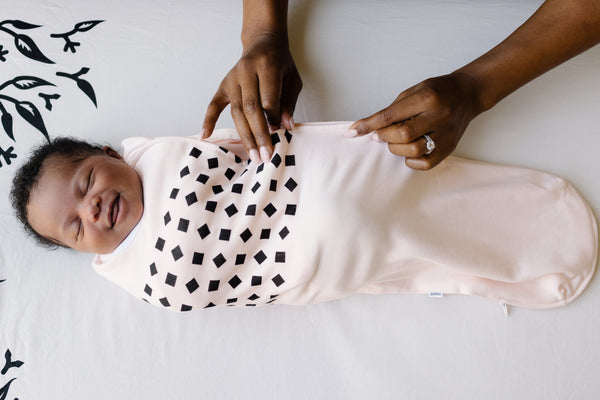Reviewed by Nanit Lab's Dr. Natalie Barnett.
At what age should you stop swaddling?
If you’re the parent of a newborn, you probably are well versed in what swaddling is and how to swaddle a newborn: It’s your secret weapon to turn a crying, fussy baby into a calm, sleepy bundle of joy. There are several benefits of swaddling, helping you and your baby enjoy longer, deeper periods of quiet sleep with fewer interruptions.
Still, as much as you love swaddling your little one, this sleep practice isn’t meant to last forever—or even more than a few months.
For safety’s sake, infants must sleep without a swaddle once they begin trying to roll over. But how long can you swaddle a baby and how do you know exactly what age to stop swaddling? And how do you make the transition from swaddle to next-step baby sleep wear as smooth and stress-free as possible?
Here, we show you how to transition your little bundle of joy out of the swaddle bundle and into their very own comfy pajamas.
When do you stop swaddling?
If your baby sleeps soundly all wrapped up in their favorite swaddle, you may be wondering why you need to stop swaddling at all. The reason is simple: Swaddling becomes a safety risk after babies hit certain developmental milestones. For example, as newborns get bigger and stronger, they may roll onto their stomach and be unable to raise their head or roll back because their arms are secured in the swaddle.
So, at what age should you stop swaddling? For safety, stop swaddling as soon as your baby shows any early signs of rolling over. In general, the American Academy of Pediatrics says that babies will begin to roll over around 3 to 4 months. Some may start as early as 8 weeks.
Signs you should stop swaddling
How will you know when your baby is ready to say so long to the swaddle? Watch for these signs:
- They’re ready (or nearly ready) to roll. If your child can roll onto one shoulder, lift their head and shoulders during tummy time, use their legs to kick and scoot, or swing their leg across their body, then it is time to stop swaddling.
- The startle or Moro reflex has faded. Many parents use swaddling to help their babies sleep without being awakened by this reflex. It’s a natural, involuntary reaction that causes the newborn to startle awake if they fling their arms open. The Moro reflex begins to fade around 12 weeks and is usually completely gone by 6 months.
- They’re breaking out or fighting the swaddle. If your baby seems frustrated by being swaddled, tries to escape, or can loosen their swaddle blanket or swaddle strap, they’re ready to move on. And PS: Some babies just hate being swaddled! That’s OK—there are lots of other options.
Transitioning your baby out of a swaddle
Now that you’ve decided that your baby has reached the age to stop using a swaddle, how do you do it without disrupting that carefully crafted sleep schedule? For most swaddled babies, the key is to make the change gradually.
- Start during naptime. Naps are usually shorter and lighter than nighttime sleep, so they’re a good opportunity to test how your baby does without a swaddle. Try a few naps first, then gradually move on to bedtime as your baby adjusts.
- Transition to a sleep sack or sleeping bag. A wearable blanket or sleep sack like our Sleeping Bag makes the perfect next step after a swaddle. Sleeping bags provide similar warmth and comfort as a swaddle, while leaving your baby’s arms free and allowing plenty of leg and hip movement.
- Start with one arm out. If your newborn isn’t quite ready to leave the swaddle behind all at once, you can ease them into it by wrapping them first with one arm free, then both.
How to get your baby to sleep without being swaddled
Transitioning out of the swaddle can be tricky for babies who have come to rely on it as a soothing tool. To ease your baby into the change, try to make the bedtime routine and the bedroom as calming as possible with these tips:
- Stick to a routine. Before you start transitioning away from the swaddle, make sure you have a familiar, consistent bedtime routine in place each time you put your baby down for sleep. Use consistent nap time and bedtime as much as possible, and follow the same steps each time.
- Create a soothing sleep environment. Make sure the room is dark, cool, and quiet. Babies sleep best in rooms between 68 and 72 degrees Fahrenheit, so check that your nursery isn’t too hot or cold. If necessary, use blackout curtains or shades to keep the room dark.
-
Add white noise or soothing sounds. Just like adults, many babies sleep more deeply with a low, steady sound in the room to drown out background noises like traffic or household noise. Use the same sound every time to train your baby’s brain to recognize the signal that it’s time to relax. Consider using a light and sound machine with a low, steady sound to create a soothing ambiance that helps drown out background noises and signals relaxation time for your little one.
Bonus: A Nanit Lab study has shown that babies who use white noise have the longest stretches of sleep that are on average 2 hours longer per night!
- Monitor sleep patterns. Transitioning out of the swaddle can take time and patience. The Nanit Pro Camera paired with our Breathing Band, Breathing Wear, Pajamas, or Sleeping Bag, lets you track your baby’s sleep and breathing motion each night and helps ensure they’re adjusting to their new sleep routine.
Make sleepy time safe and simple with Nanit
Transitioning away from swaddling can be challenging for you and your little one, but it’s an important milestone as they leave their newborn days behind. Remember, you don’t have to take this journey alone—Nanit is here to support you every step of the way.
With baby sleep wear like our Breathing Wear Swaddle and Sleep Wear Swaddle as well as our baby monitoring app, you can easily track the baby sleep position and breathing rate all night long. You can even track their growth over time with our Smart Sheets and our Watch Them Grow feature in the app. You’ll get an instant alert if baby needs you, plus daily, weekly, and monthly reports to track sleep patterns and tweak as needed.
Whether it’s a comfy sleeping bag, cozy pajamas, or HD monitoring and sleep reports, Nanit has everything your baby needs to safely drift off to dreamland.
Editorial Team
Dr. Natalie Barnett:
 Natalie Barnett serves as VP of Clinical Research at Nanit. Natalie initiated sleep research collaborations at Nanit and in her current role, Natalie oversees collaborations with researchers at hospitals and universities around the world who use the Nanit camera to better understand pediatric sleep and leads the internal sleep and development research programs at Nanit. Natalie holds a Ph.D. in Genetics from the University of New England in Australia and a Postgraduate Certificate in Pediatric Sleep Science from the University of Western Australia. Natalie was an Assistant Professor in the Neurogenetics Unit at NYU School of Medicine prior to joining Nanit. Natalie is also the voice of Nanit's science-backed, personalized sleep tips delivered to users throughout their baby's first few years.
Natalie Barnett serves as VP of Clinical Research at Nanit. Natalie initiated sleep research collaborations at Nanit and in her current role, Natalie oversees collaborations with researchers at hospitals and universities around the world who use the Nanit camera to better understand pediatric sleep and leads the internal sleep and development research programs at Nanit. Natalie holds a Ph.D. in Genetics from the University of New England in Australia and a Postgraduate Certificate in Pediatric Sleep Science from the University of Western Australia. Natalie was an Assistant Professor in the Neurogenetics Unit at NYU School of Medicine prior to joining Nanit. Natalie is also the voice of Nanit's science-backed, personalized sleep tips delivered to users throughout their baby's first few years.
Sources:
American Academy of Pediatrics. How to keep your sleeping baby safe: AAP policy explained. https://www.healthychildren.org/English/ages-stages/baby/sleep/Pages/A-Parents-Guide-to-Safe-Sleep
International Journal of Pediatrics. The grasp reflex and Moro reflex in infants: Hierarchy of primitive reflex responses. https://www.ncbi.nlm.nih.gov/pmc/articles/PMC3384944/
Pediatrics. Spontaneous Arousals in supine infants while swaddled and unswaddled during rapid eye movement and quiet sleep. https://doi.org/10.1542/peds.110.6.e70








































